In Silico Characterization of Gelsemium Compounds as Glycine Receptor Ligands
Abstract
1. Introduction
2. Materials and Methods
2.1. Library Preparation
2.2. ADMET and Toxicologic Profiling Gelsemium Compounds
2.3. Protein Selection and Preparation
2.4. Protein-Ligand Docking
2.5. Molecular Dynamics Simulations
3. Results
3.1. Pharmacokinetic and Toxicological Profile of Gelsemium Compounds
3.2. Glycine Receptors Binding Predictions for Gelsemium Compounds
4. Discussion
5. Conclusions
Supplementary Materials
Author Contributions
Funding
Data Availability Statement
Acknowledgments
Conflicts of Interest
Abbreviations
| ADMET | Absorption, Distribution, Metabolism, Excretion, and Toxicity |
| AMES | Ames test for mutagenicity |
| BBB | Blood–Brain Barrier |
| CL | Clearence |
| CNS | Central Nervous System |
| DILI | Drug-Induced Liver Injury |
| PHOA | Predicted Human Oral Absorption |
| HERG I | Human Ether-à-go-go-Related Gene inhibition (Kv11.1 potassium channel) |
| MM-GBSA | Molecular Mechanics Generalized Born Surface Area |
| RMSD | Root Mean Square Deviation |
| RMSF | Root Mean Square Fluctuation |
| MD | Molecular Dynamics |
| ΔGbind | Binding Free Energy |
| Pgp | P-glycoprotein |
| LIP | Lipinski’s Rule of Five violations |
| VEB | Veber’s Rule violations |
| OA | Oral Absorption |
| QPlogBB | Predicted log of Brain/Blood Partition Coefficient |
References
- Lin, H.; Qiu, H.; Cheng, Y.; Liu, M.; Chen, M.; Que, Y.; Que, W. Gelsemium elegans Benth: Chemical Components, Pharmacological Effects, and Toxicity Mechanisms. Molecules 2021, 26, 7145. [Google Scholar] [CrossRef]
- Wang, L.; Chen, S.; Gao, X.; Liang, X.; Lv, W.; Zhang, D.; Jin, X. Recent progress in chemistry and bioactivity of monoterpenoid indole alkaloids from the genus gelsemium: A comprehensive review. J. Enzyme Inhib. Med. Chem. 2023, 38, 2155639. [Google Scholar] [CrossRef]
- Jin, G.L.; Su, Y.P.; Liu, M.; Xu, Y.; Yang, J.; Liao, K.J.; Yu, C.X. Medicinal plants of the genus Gelsemium (Gelsemiaceae, Gentianales)—A review of their phytochemistry, pharmacology, toxicology and traditional use. J. Ethnopharmacol. 2014, 152, 33–52. [Google Scholar] [CrossRef]
- Rujjanawate, C.; Kanjanapothi, D.; Panthong, A. Pharmacological effect and toxicity of alkaloids from Gelsemium elegans Benth. J. Ethnopharmacol. 2003, 89, 91–95. [Google Scholar] [CrossRef] [PubMed]
- Jia, Y.; Wang, M.; van Andel, T. Revisiting traditional Chinese materia medica from European historical collections and perspective for current use. J. Tradit. Complement. Med. 2022, 12, 206–216. [Google Scholar] [CrossRef] [PubMed]
- Bellavite, P.; Magnani, P.; Zanolin, E.; Conforti, A. Homeopathic Doses of Gelsemium sempervirens Improve the Behavior of Mice in Response to Novel Environments. Evid. Based Complement. Altern. Med. 2011, 2011, 362517. [Google Scholar] [CrossRef]
- Peng, Y.L.; Liang, J.J.; Xue, Y.; Khan, A.; Zhang, P.P.; Feng, T.T.; Song, D.; Zhou, Y.; Wei, X. Genus Gelsemium and its Endophytic Fungi—Comprehensive Review of their Traditional Uses, Phytochemistry, Pharmacology, and Toxicology. Curr. Top. Med. Chem. 2023, 23, 2452–2487. [Google Scholar] [CrossRef]
- Zhou, Z.; Wu, L.; Zhong, Y.; Fang, X.; Liu, Y.; Chen, H.; Zhang, W. Gelsemium elegans Poisoning: A Case with 8 Months of Follow-up and Review of the Literature. Front. Neurol. 2017, 8, 204. [Google Scholar] [CrossRef]
- Lara, C.O.; Murath, P.; Munoz, B.; Marileo, A.M.; Martin, L.S.; San Martin, V.P.; Burgos, C.F.; Mariqueo, T.A.; Aguayo, L.G.; Fuentealba, J.; et al. Functional modulation of glycine receptors by the alkaloid gelsemine. Br. J. Pharmacol. 2016, 173, 2263–2277. [Google Scholar] [CrossRef]
- Li, Y.J.; Xiao, N.; Jia, W.D.; Li, X.R.; Zheng, X.F.; Sun, Z.L. The Effectiveness of Flumazenil-Epinephrine Combination on Treatment for Acute Gelsemium elegans Poisoning. Acta Vet. Zootech. Sin. 2022, 53, 938–946. [Google Scholar]
- Marileo, A.M.; Gavilan, J.; San Martin, V.P.; Lara, C.O.; Sazo, A.; Munoz-Montesino, C.; Castro, P.A.; Burgos, C.F.; Leiva-Salcedo, E.; Aguayo, L.G.; et al. Modulation of GABA(A) receptors and of GABAergic synapses by the natural alkaloid gelsemine. Front. Mol. Neurosci. 2022, 15, 1083189. [Google Scholar]
- Marileo, A.M.; Lara, C.O.; Sazo, A.; Contreras, O.V.; Gonzalez, G.; Castro, P.A.; Aguayo, L.G.; Moraga-Cid, G.; Fuentealba, J.; Burgos, C.F.; et al. Molecular Pharmacology of Gelsemium Alkaloids on Inhibitory Receptors. Int. J. Mol. Sci. 2024, 25, 3390. [Google Scholar] [CrossRef] [PubMed]
- Bode, A.; Lynch, J.W. The impact of human hyperekplexia mutations on glycine receptor structure and function. Mol. Brain 2014, 7, 2. [Google Scholar] [CrossRef] [PubMed]
- Winkelmann, A.; Maggio, N.; Eller, J.; Caliskan, G.; Semtner, M.; Haussler, U.; Juttner, R.; Dugladze, T.; Smolinsky, B.; Kowalczyk, S.; et al. Changes in neural network homeostasis trigger neuropsychiatric symptoms. J. Clin. Investig. 2014, 124, 696–711. [Google Scholar] [CrossRef] [PubMed]
- Pilorge, M.; Fassier, C.; Le Corronc, H.; Potey, A.; Bai, J.; De Gois, S.; Delaby, E.; Assouline, B.; Guinchat, V.; Devillard, F.; et al. Genetic and functional analyses demonstrate a role for abnormal glycinergic signaling in autism. Mol. Psychiatry 2016, 21, 936–945. [Google Scholar] [CrossRef]
- San Martin, V.P.; Sazo, A.; Utreras, E.; Moraga-Cid, G.; Yevenes, G.E. Glycine Receptor Subtypes and Their Roles in Nociception and Chronic Pain. Front. Mol. Neurosci. 2022, 15, 848642. [Google Scholar] [CrossRef]
- Zeilhofer, H.U.; Werynska, K.; Gingras, J.; Yevenes, G.E. Glycine Receptors in Spinal Nociceptive Control-An Update. Biomolecules 2021, 11, 846. [Google Scholar] [CrossRef]
- Cioffi, C.L. Modulation of Glycine-Mediated Spinal Neurotransmission for the Treatment of Chronic Pain. J. Med. Chem. 2018, 61, 2652–2679. [Google Scholar] [CrossRef]
- Sadybekov, A.V.; Katritch, V. Computational approaches streamlining drug discovery. Nature 2023, 616, 673–685. [Google Scholar] [CrossRef]
- Kim, S.; Chen, J.; Cheng, T.; Gindulyte, A.; He, J.; He, S.; Li, Q.; Shoemaker, B.A.; Thiessen, P.A.; Yu, B.; et al. PubChem 2025 update. Nucleic Acids Res. 2025, 53, D1516–D1525. [Google Scholar] [CrossRef]
- Zdrazil, B.; Felix, E.; Hunter, F.; Manners, E.J.; Blackshaw, J.; Corbett, S.; de Veij, M.; Ioannidis, H.; Lopez, D.M.; Mosquera, J.F.; et al. The ChEMBL Database in 2023: A drug discovery platform spanning multiple bioactivity data types and time periods. Nucleic Acids Res. 2024, 52, D1180–D1192. [Google Scholar] [CrossRef] [PubMed]
- Chen, W.; Ma, Y.; He, W.; Wu, Y.; Huang, Y.; Zhang, Y.; Tian, H.; Wei, K.; Yang, X.; Zhang, H. Structure units oriented approach towards collective synthesis of sarpagine-ajmaline-koumine type alkaloids. Nat. Commun. 2022, 13, 908. [Google Scholar] [CrossRef] [PubMed]
- Shi, B.B.; Zhang, G.R.; Li, Z.H.; Liu, J.K. Three new oxygenated yohimbane-type alkaloids from Ophiorrhiza japonica. Fitoterapia 2023, 166, 105442. [Google Scholar] [CrossRef] [PubMed]
- Bergman, M.E.; Franks, A.E.; Phillips, M.A. Biosynthesis, natural distribution, and biological activities of acyclic monoterpenes and their derivatives. Phytochem. Rev. 2023, 22, 361–384. [Google Scholar] [CrossRef]
- El-Sayed, H.M.; Rasheed, D.M.; Mahrous, E.A.; Abdel-Sattar, E. C(13)-Norisoprenoid megastigmanes: Biosynthesis, classification, natural sources, biological activities, and structure-activity relationship—A comprehensive review. Fitoterapia 2025, 183, 106472. [Google Scholar] [CrossRef]
- Litzenburger, M.; Bernhardt, R. Selective oxidation of carotenoid-derived aroma compounds by CYP260B1 and CYP267B1 from Sorangium cellulosum So ce56. Appl. Microbiol. Biotechnol. 2016, 100, 4447–4457. [Google Scholar] [CrossRef]
- Barreira, J.C.M.; Ferreira, I.C.F.R. Steroids in natural matrices. In Biotechnology of Bioactive Compounds; Wiley & Sons, Ltd.: New York, NY, USA, 2015; pp. 395–431. [Google Scholar]
- Xu, W.H.; Zhao, P.; Wang, M.; Liang, Q. Naturally occurring furofuran lignans: Structural diversity and biological activities. Nat. Prod. Res. 2019, 33, 1357–1373. [Google Scholar] [CrossRef]
- Zhao, Q.C.; Hua, W.; Zhang, L.; Guo, T.; Zhao, M.H.; Yan, M.; Wu, L.J. Two new alkaloids from Gelsemium elegans. J. Asian Nat. Prod. Res. 2010, 12, 273–277. [Google Scholar] [CrossRef]
- Daina, A.; Michielin, O.; Zoete, V. SwissADME: A free web tool to evaluate pharmacokinetics, drug-likeness and medicinal chemistry friendliness of small molecules. Sci. Rep. 2017, 7, 42717. [Google Scholar] [CrossRef]
- Pires, D.E.; Blundell, T.L.; Ascher, D.B. pkCSM: Predicting Small-Molecule Pharmacokinetic and Toxicity Properties Using Graph-Based Signatures. J. Med. Chem. 2015, 58, 4066–4072. [Google Scholar] [CrossRef]
- Lipinski, C.A.; Lombardo, F.; Dominy, B.W.; Feeney, P.J. Experimental and computational approaches to estimate solubility and permeability in drug discovery and development settings. Adv. Drug Deliv. Rev. 2001, 46, 3–26. [Google Scholar] [CrossRef]
- Veber, D.F.; Johnson, S.R.; Cheng, H.Y.; Smith, B.R.; Ward, K.W.; Kopple, K.D. Molecular properties that influence the oral bioavailability of drug candidates. J. Med. Chem. 2002, 45, 2615–2623. [Google Scholar] [CrossRef] [PubMed]
- Klimoszek, D.; Jelen, M.; Dolowy, M.; Morak-Mlodawska, B. Study of the Lipophilicity and ADMET Parameters of New Anticancer Diquinothiazines with Pharmacophore Substituents. Pharmaceuticals 2024, 17, 725. [Google Scholar] [CrossRef] [PubMed]
- Dulsat, J.; Lopez-Nieto, B.; Estrada-Tejedor, R.; Borrell, J.I. Evaluation of Free Online ADMET Tools for Academic or Small Biotech Environments. Molecules 2023, 28, 776. [Google Scholar] [CrossRef] [PubMed]
- Marin, D.E.; Taranu, I. Using In Silico Approach for Metabolomic and Toxicity Prediction of Alternariol. Toxins 2023, 15, 421. [Google Scholar] [CrossRef]
- Gibbs, E.; Klemm, E.; Seiferth, D.; Kumar, A.; Ilca, S.L.; Biggin, P.C.; Chakrapani, S. Conformational transitions and allosteric modulation in a heteromeric glycine receptor. Nat. Commun. 2023, 14, 1363. [Google Scholar] [CrossRef]
- Huang, X.; Shaffer, P.L.; Ayube, S.; Bregman, H.; Chen, H.; Lehto, S.G.; Luther, J.A.; Matson, D.J.; McDonough, S.I.; Michelsen, K.; et al. Crystal structures of human glycine receptor alpha3 bound to a novel class of analgesic potentiators. Nat. Struct. Mol. Biol. 2017, 24, 108–113. [Google Scholar] [CrossRef]
- Huang, X.; Chen, H.; Michelsen, K.; Schneider, S.; Shaffer, P.L. Crystal structure of human glycine receptor-alpha3 bound to antagonist strychnine. Nature 2015, 526, 277–280. [Google Scholar] [CrossRef]
- Lu, C.; Wu, C.; Ghoreishi, D.; Chen, W.; Wang, L.; Damm, W.; Ross, G.A.; Dahlgren, M.K.; Russell, E.; Von Bargen, C.D.; et al. OPLS4: Improving Force Field Accuracy on Challenging Regimes of Chemical Space. J. Chem. Theory Comput. 2021, 17, 4291–4300. [Google Scholar] [CrossRef]
- Shoaib, T.H.; Abdelmoniem, N.; Mukhtar, R.M.; Alqhtani, A.T.; Alalawi, A.L.; Alawaji, R.; Althubyani, M.S.; Mohamed, S.G.A.; Mohamed, G.A.; Ibrahim, S.R.M.; et al. Molecular Docking and Molecular Dynamics Studies Reveal the Anticancer Potential of Medicinal-Plant-Derived Lignans as MDM2-P53 Interaction Inhibitors. Molecules 2023, 28, 6665. [Google Scholar] [CrossRef]
- Long, J.Y.; Wang, Z.Y.; Zuo, M.T.; Huang, S.J.; Ma, X.; Qi, X.J.; Huang, C.Y.; Liu, Z.Y. Effect of cytochrome P450 3A4 on tissue distribution of humantenmine, koumine, and gelsemine, three alkaloids from the toxic plant Gelsemium. Toxicol. Lett. 2024, 397, 34–41. [Google Scholar] [CrossRef]
- Hu, Y.; Wang, Z.; Huang, X.; Xia, B.; Tang, L.; Zheng, Z.; Ye, L. Oxidative metabolism of koumine is mainly catalyzed by microsomal CYP3A4/3A5. Xenobiotica 2017, 47, 584–591. [Google Scholar] [CrossRef]
- Shen, X.; Ma, J.; Wang, X.; Wen, C.; Zhang, M. Toxicokinetics of 11 Gelsemium Alkaloids in Rats by UPLC-MS/MS. Biomed. Res. Int. 2020, 2020, 8247270. [Google Scholar] [CrossRef] [PubMed]
- Xiang, Z.; Qiu, J.; He, X.; Yu, X. Toxicokinetics, in vivo metabolic profiling, and in vitro metabolism of gelsenicine in rats. Arch. Toxicol. 2022, 96, 525–533. [Google Scholar] [CrossRef] [PubMed]
- Zhang, H.H.; Yang, W.J.; Huang, Y.J.; Li, W.J.; Zhang, S.X.; Liu, Z.Y. The metabolism of gelsevirine in human, pig, goat and rat liver microsomes. Vet. Med. Sci. 2021, 7, 2086–2092. [Google Scholar] [CrossRef] [PubMed]
- You, G.; Yang, R.; Wei, Y.; Hu, W.; Gan, L.; Xie, C.; Zheng, Z.; Liu, Z.; Liao, R.; Ye, L. The detoxification effect of cytochrome P450 3A4 on gelsemine-induced toxicity. Toxicol. Lett. 2021, 353, 34–42. [Google Scholar] [CrossRef]
- Yu, H.; Tang, M.H.; Zeng, Z.Y.; Huang, S.J.; Zheng, X.F.; Liu, Z.Y. Suppressive Effects of Gelsemine on Anxiety-like Behaviors Induced by Chronic Unpredictable Mild Stress in Mice. Brain Sci. 2022, 12, 191. [Google Scholar] [CrossRef]
- Wu, Y.E.; Li, Y.D.; Luo, Y.J.; Wang, T.X.; Wang, H.J.; Chen, S.N.; Qu, W.M.; Huang, Z.L. Gelsemine alleviates both neuropathic pain and sleep disturbance in partial sciatic nerve ligation mice. Acta Pharmacol. Sin. 2015, 36, 1308–1317. [Google Scholar] [CrossRef]
- Zhang, J.Y.; Gong, N.; Huang, J.L.; Guo, L.C.; Wang, Y.X. Gelsemine, a principal alkaloid from Gelsemium sempervirens Ait., exhibits potent and specific antinociception in chronic pain by acting at spinal α3 glycine receptors. PAIN® 2013, 154, 2452–2462. [Google Scholar] [CrossRef]
- Meyer, L.; Boujedaini, N.; Patte-Mensah, C.; Mensah-Nyagan, A.G. Pharmacological effect of gelsemine on anxiety-like behavior in rat. Behav. Brain Res. 2013, 253, 90–94. [Google Scholar] [CrossRef]
- Xu, W.B.; Tang, M.H.; Long, J.Y.; Wang, W.W.; Qin, J.Y.; Qi, X.J.; Liu, Z.Y. Antinociceptive effect of gelsenicine, principal toxic alkaloids of gelsemium, on prostaglandin E2-induced hyperalgesia in mice: Comparison with gelsemine and koumine. Biochem. Biophys. Res. Commun. 2023, 681, 55–61. [Google Scholar] [CrossRef]
- Liu, M.; Huang, H.H.; Yang, J.; Su, Y.P.; Lin, H.W.; Lin, L.Q.; Liao, W.J.; Yu, C.X. The active alkaloids of Gelsemium elegans Benth. are potent anxiolytics. Psychopharmacology 2013, 225, 839–851. [Google Scholar] [CrossRef]
- Xiong, B.; Zhong, Z.; Chen, C.; Huang, H.; Lin, J.; Xu, Y.; Yang, J.; Yu, C. The anxiolytic effect of koumine on a predatory sound stress-induced anxiety model and its associated molecular mechanisms. Phytomedicine 2022, 103, 154225. [Google Scholar] [CrossRef] [PubMed]
- Wang, Z.Y.; Zuo, M.T.; Liu, Z.Y. The Metabolism and Disposition of Koumine, Gelsemine and Humantenmine from Gelsemium. Curr. Drug Metab. 2019, 20, 583–591. [Google Scholar] [CrossRef] [PubMed]
- Qi, X.J.; Zuo, M.T.; Huang, S.J.; Ma, X.; Wang, Z.Y.; Liu, Z.Y. Metabolic profile and tissue distribution of Humantenirine, an oxindole alkaloid from Gelsemium, after oral administration in rats. J. Chromatogr. B Anal. Technol. Biomed. Life Sci. 2021, 1181, 122901. [Google Scholar] [CrossRef] [PubMed]
- Li, Y.J.; Yang, K.; Long, X.M.; Xiao, G.; Huang, S.J.; Zeng, Z.Y.; Liu, Z.Y.; Sun, Z.L. Toxicity assessment of gelsenicine and the search for effective antidotes. Hum. Exp. Toxicol. 2022, 41, 09603271211062857. [Google Scholar] [CrossRef]
- Ma, X.; Wang, Z.Y.; Zuo, M.T.; Yang, K.; Sun, Z.L.; Wu, Y.; Liu, Z.Y. Excretion, Metabolism, and Tissue Distribution of Gelsemium elegans (Gardn. & Champ.) Benth in Pigs. Molecules 2022, 27, 2605. [Google Scholar] [CrossRef]
- Zhai, J.; Yan, H.; Liu, M.; Jiang, C.; Jin, M.; Xie, B.; Ma, C.; Cong, B.; Wen, D. Decoding gelsenicine-induced neurotoxicity in mice via metabolomics and network toxicology. Phytomedicine 2025, 142, 156753. [Google Scholar] [CrossRef]
- Wu, T.; Chen, G.; Chen, X.; Wang, Q.; Wang, G. Anti-hyperlipidemic and anti-oxidative effects of gelsemine in high-fat-diet-fed rabbits. Cell Biochem. Biophys. 2015, 71, 337–344. [Google Scholar] [CrossRef]
- Lin, L.; Zheng, J.; Zhu, W.; Jia, N. Nephroprotective effect of gelsemine against cisplatin-induced toxicity is mediated via attenuation of oxidative stress. Cell Biochem. Biophys. 2015, 71, 535–541. [Google Scholar] [CrossRef]
- Jin, G.L.; Liu, H.P.; Huang, Y.X.; Zeng, Q.Q.; Chen, J.X.; Lan, X.B.; Xin, Z.M.; Xiong, B.J.; Yue, R.C.; Yu, C.X. Koumine regulates macrophage M1/M2 polarization via TSPO, alleviating sepsis-associated liver injury in mice. Phytomedicine 2022, 107, 154484. [Google Scholar] [CrossRef]
- Lin, Y.R.; Zheng, F.T.; Xiong, B.J.; Chen, Z.H.; Chen, S.T.; Fang, C.N.; Yu, C.X.; Yang, J. Koumine alleviates rheumatoid arthritis by regulating macrophage polarization. J. Ethnopharmacol. 2023, 311, 116474. [Google Scholar] [CrossRef] [PubMed]
- Yang, J.; Lin, Y.R.; Xiong, B.J.; Chen, Z.H.; Luo, Y.F.; Xu, Y.; Su, Y.P.; Huang, H.H.; Yu, C.X. Regulation effect of koumine on T-helper cell polarization in rheumatoid arthritis. Eur. J. Pharmacol. 2022, 937, 175387. [Google Scholar] [CrossRef] [PubMed]
- Yue, R.; Jin, G.; Wei, S.; Huang, H.; Su, L.; Zhang, C.; Xu, Y.; Yang, J.; Liu, M.; Chu, Z.; et al. Immunoregulatory Effect of Koumine on Nonalcoholic Fatty Liver Disease Rats. J. Immunol. Res. 2019, 2019, 8325102. [Google Scholar] [CrossRef] [PubMed]
- Feng, M.; Kong, D.; Guo, H.; Xing, C.; Lv, J.; Bian, H.; Lv, N.; Zhang, C.; Chen, D.; Liu, M.; et al. Gelsevirine improves age-related and surgically induced osteoarthritis in mice by reducing STING availability and local inflammation. Biochem. Pharmacol. 2022, 198, 114975. [Google Scholar] [CrossRef]
- Long, J.; Tang, M.; Zuo, M.; Xu, W.; Meng, S.; Liu, Z. The antianxiety effects of koumine and gelsemine, two main active components in the traditional Chinese herbal medicine Gelsemium: A comprehensive review. Brain-X 2023, 1, e46. [Google Scholar] [CrossRef]
- Li, N.; Yang, Y.; Zhang, S.; Jiang, B.; Zhang, W.; Wang, H.; Chen, L.; Wang, L.; Li, Y.; Shi, L. The toxic components, toxicological mechanism and effective antidote for Gelsemium elegans poisoning. Acta Pharm. Sin. B 2025, 15, 4872–4885. [Google Scholar] [CrossRef]
- Huang, C.-Y.; Huang, S.-J.; Yu, H.; Tang, M.-H.; Liu, Z.-Y. The toxicology and detoxification of Gelsemium: Traditional and modern views. Pharmacol. Res.-Mod. Chin. Med. 2024, 12, 100482. [Google Scholar] [CrossRef]
- Shoaib, R.M.; Zhang, J.Y.; Mao, X.F.; Wang, Y.X. Gelsemine and koumine, principal active ingredients of Gelsemium, exhibit mechanical antiallodynia via spinal glycine receptor activation-induced allopregnanolone biosynthesis. Biochem. Pharmacol. 2019, 161, 136–148. [Google Scholar] [CrossRef]
- Kumar, A.; Kindig, K.; Rao, S.; Zaki, A.-M.; Basak, S.; Sansom, M.S.; Biggin, P.C.; Chakrapani, S. Structural basis for cannabinoid-induced potentiation of alpha1-glycine receptors in lipid nanodiscs. Nat. Commun. 2022, 13, 4862. [Google Scholar] [CrossRef]
- Jalalypour, F.; Howard, R.J.; Lindahl, E. Allosteric cholesterol site in glycine receptors characterized through molecular simulations. J. Phys. Chem. B 2024, 128, 4996–5007. [Google Scholar] [CrossRef]
- Thompson, J.R.; Beaudoin, C.A.; Lummis, S.C. Modelling and molecular dynamics predict the structure and interactions of the glycine receptor intracellular domain. Biomolecules 2023, 13, 1757. [Google Scholar] [CrossRef]
- Bartocci, A.; Grazzi, A.; Awad, N.; Corringer, P.-J.; Souza, P.C.; Cecchini, M. A millisecond coarse-grained simulation approach to decipher allosteric cannabinoid binding at the glycine receptor α 1. Nat. Commun. 2024, 15, 9040. [Google Scholar] [CrossRef]
- Mhashal, A.R.; Yoluk, O.; Orellana, L. Exploring the Conformational Impact of Glycine Receptor TM1-2 Mutations Through Coarse-Grained Analysis and Atomistic Simulations. Front. Mol. Biosci. 2022, 9, 890851. [Google Scholar] [CrossRef]
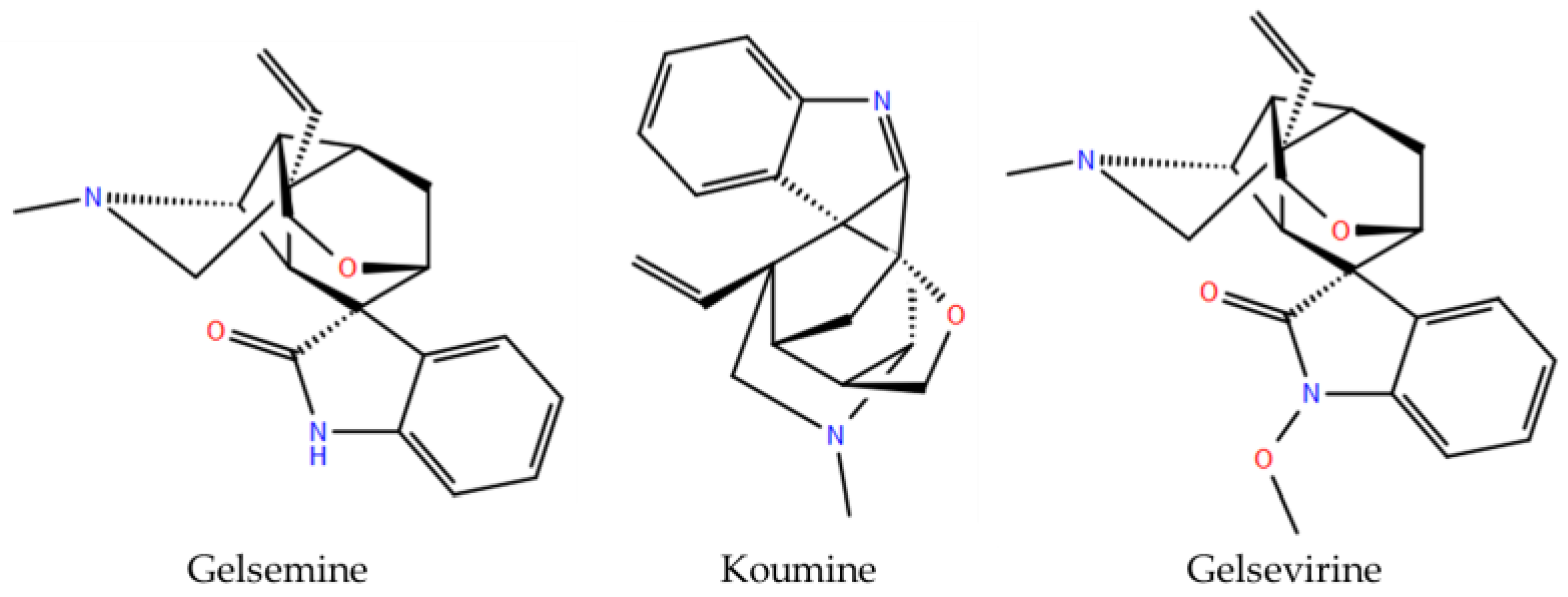
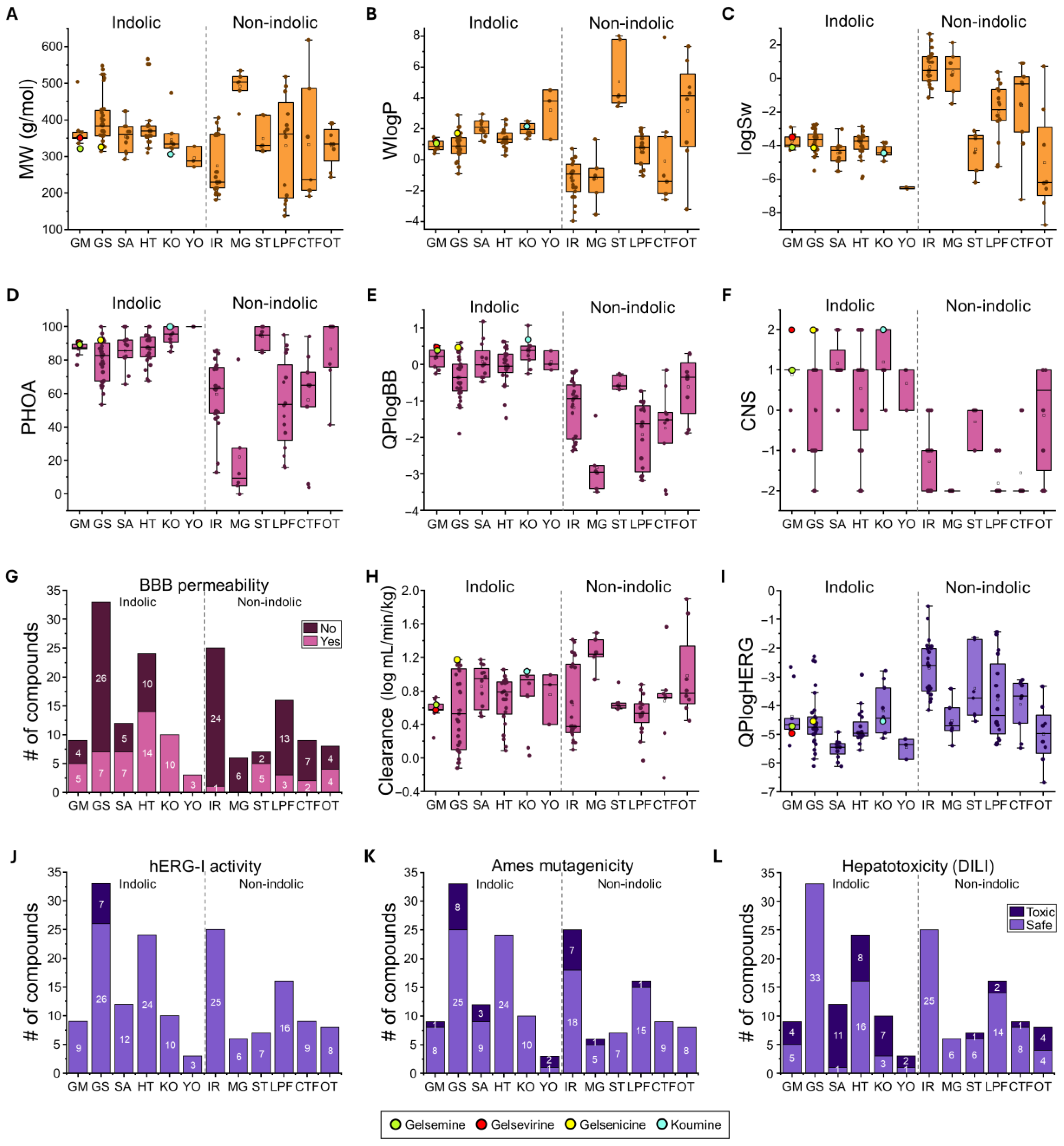



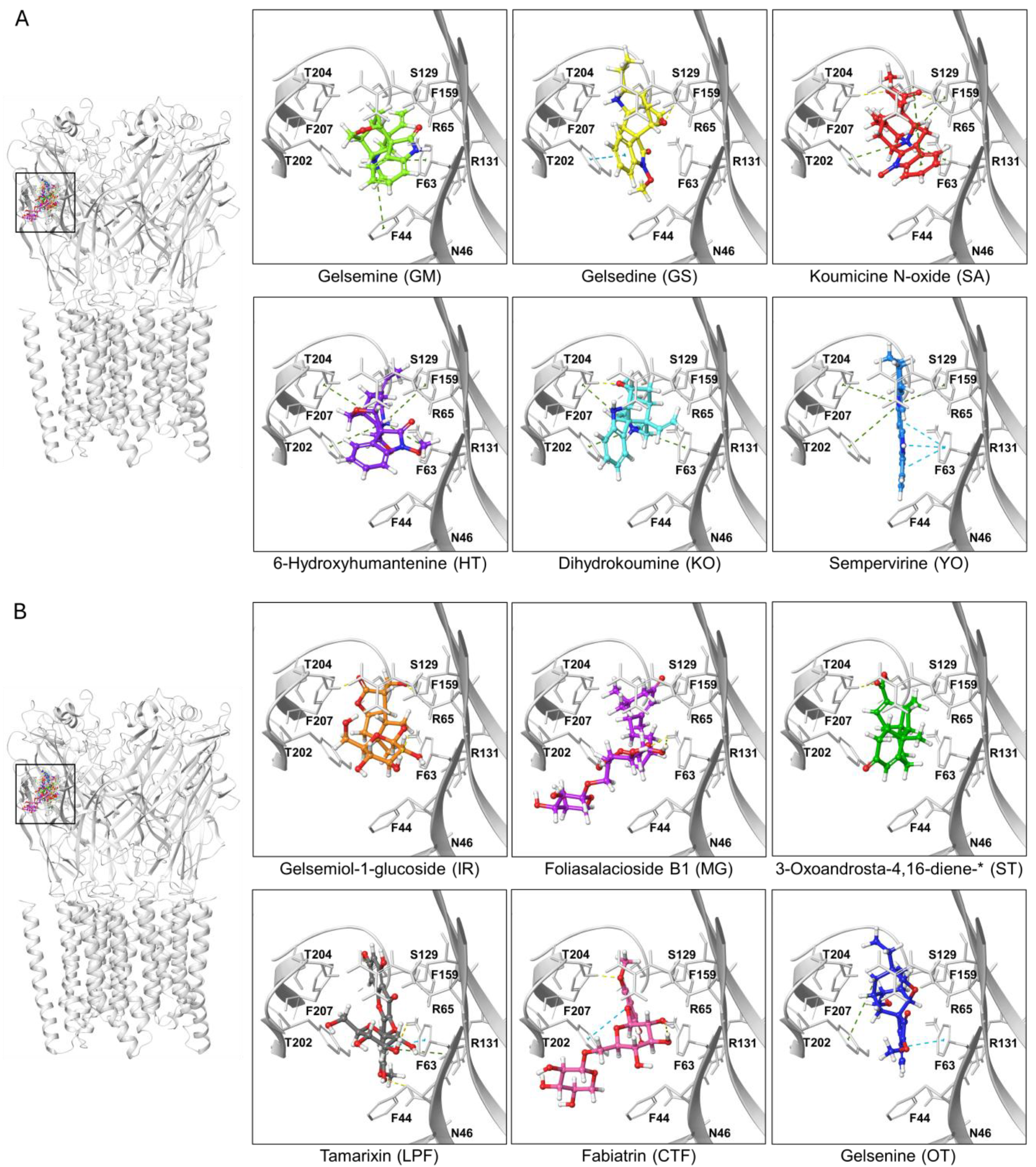
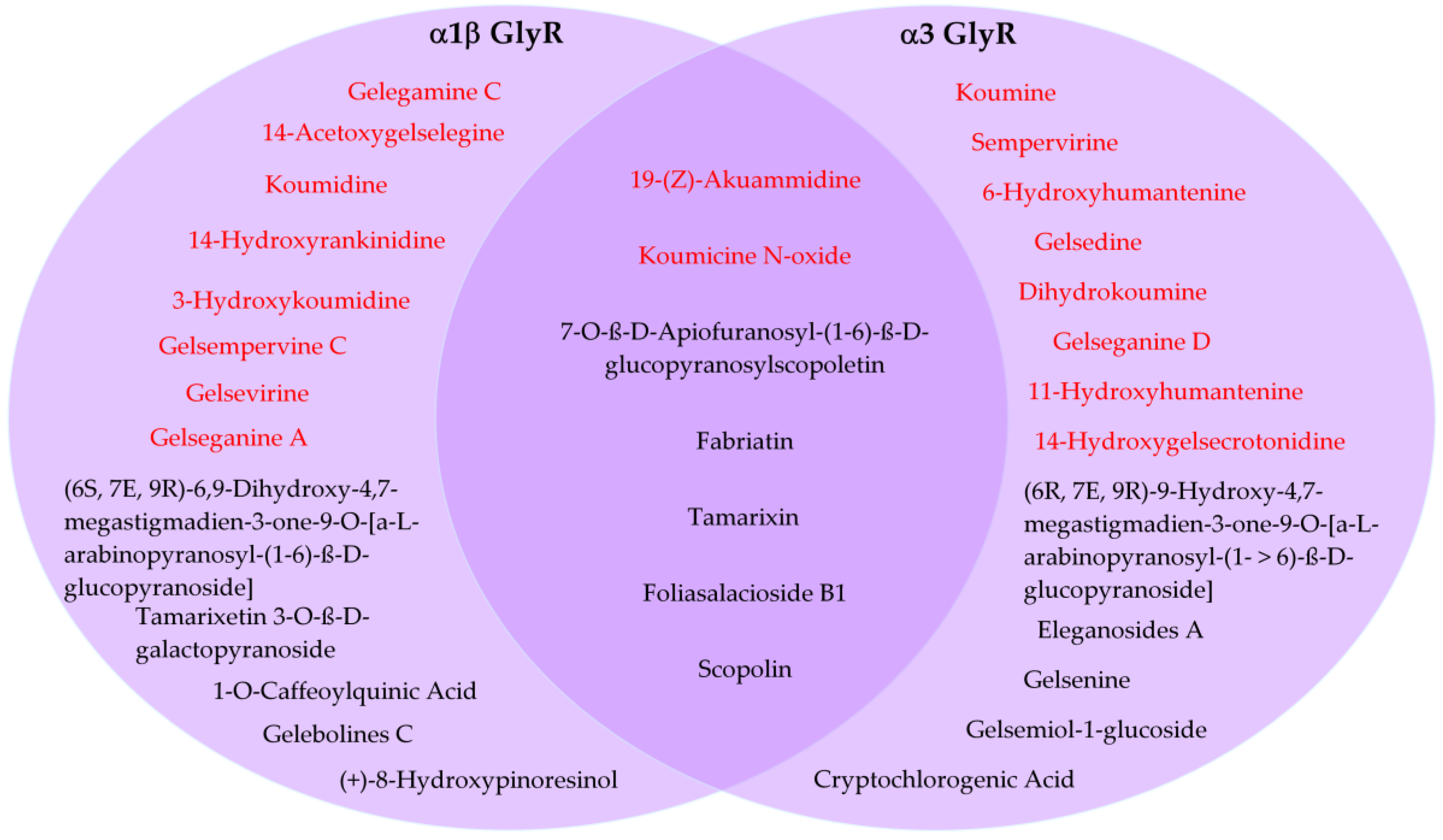
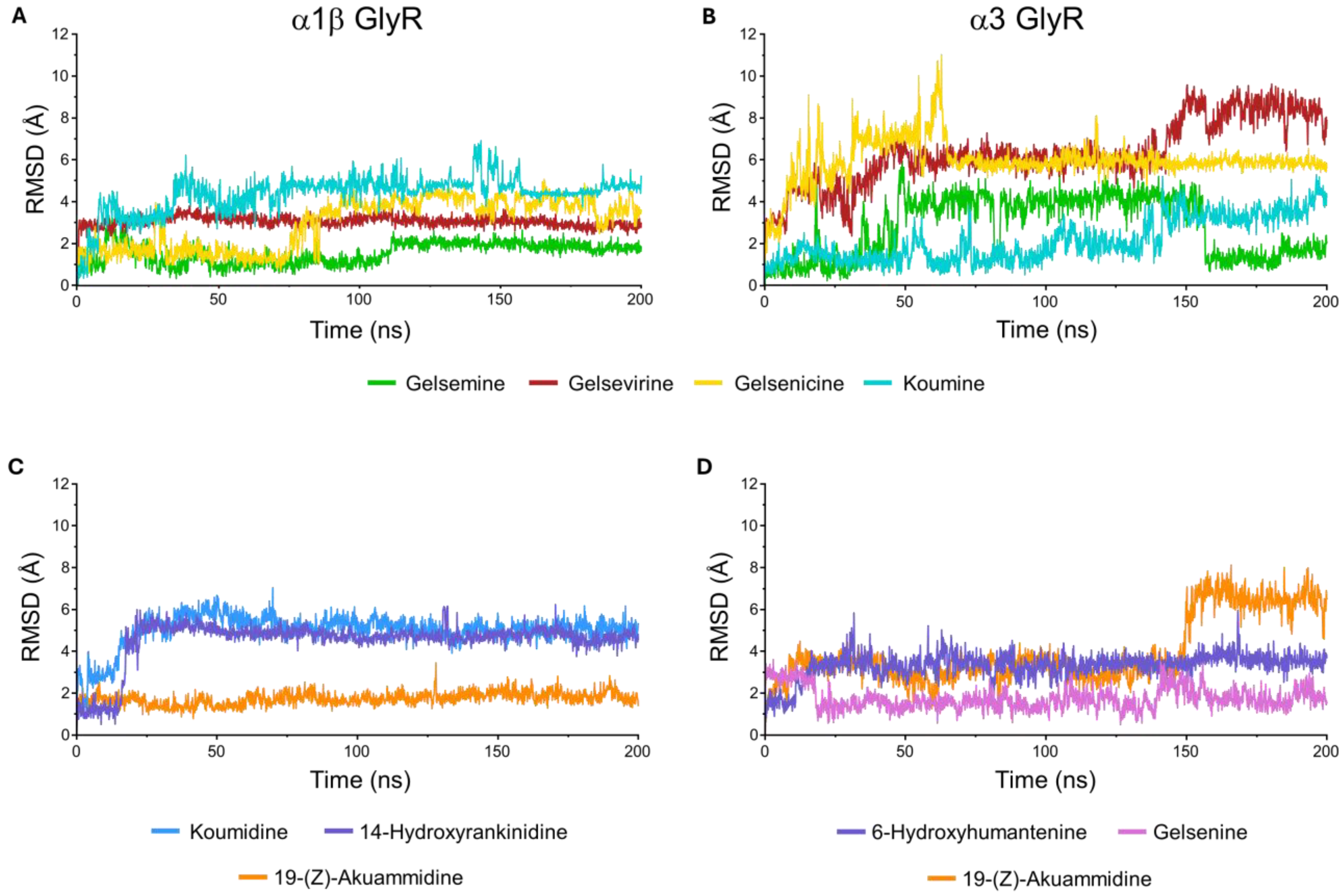
| Group | Number | Molecules |
|---|---|---|
| Indolic compounds | ||
| Gelsedine (GS) | 33 | 11-Methoxygelsecrotonidine, 11,14-Dihydroxygelsenicine, 14-Acetoxy-15-hydroxygelsenicine, 14-Acetoxygelselegine, 14α-Hydroxygelsamydine, 14α-Hydroxyelegansamine, 14-Dehydroxygelsefuranidine, 14-Hydroxygelsecrotonidine, 14-Hydroxygelsedilam, 14-Hydroxygelsenicine, 14,15-Dihydroxygelsenicine, 15-Hydroxy-Nb-methylgelsedilam, 19α-Hydroxygelsamydine, 19-Oxogelsenicine, 4,20-Dehydrogelsemicine, Gelegamine C, Gelegamine E, Gelsecrotonidine, Gelsedilam, Gelsedine, Gelsefuranidine, Gelseganine D, Gelseiridone, Gelselenidine, Gelsemicine, Gelseziridine, Gs-1, Gs-3, Gelsemolenine A, Gelsemolenine B, Gelsemoxonine, Gelsenicine, Gelseoxazolidinine |
| Gelsemine (GM) | 9 | 19R-Hydroxydihydrogelsemine, 19-(R)-Hydroxydihydrogelsevirine, 21-Oxogelsemine, 21-Oxogelsevirine, Gelsebanine, Gelsemine, Gelsevirine, Gelsevirine N-oxide, Nb-Demethylgelsevirine |
| Humantenine (HT) | 24 | 19(E)-Humantenine, (4R)-Humantenine N4-oxide, 4,5-Dehydrorankinidine, 6-Hydroxyhumantenine, 11-Hydroxyhumantenine, 11-Hydroxyrankinidine, 11-Methoxygelsemamide, 11-Methoxyhumantenine, 14-Hydroxyrankinidine, 15-Hydroxyhumantenine, 15-Hydroxyrankinidine, 20-Hydroxydihydrorankinidine, Gelegamine A, Gelegamine B, Gelseganine A, Gelsemamide, Humantenine, Humanteniridine, Humantenirine, Humantenoxenine, N-Desmethoxyhumantenine, N-Desmethoxyrankinidine, Rankinidine, Rankiniridine |
| Koumine (KO) | 10 | 21-(2-oxopropyl)-koumine, 21-Oxokoumine, 19-(R)-Hydroxydihydrokoumine, 19-(S)-Hydroxydihydrokoumine, Dihydrokoumine, Furanokoumine, Gelseganine C, Koumine, Kounaminal, Koumine N-oxide |
| Sarpagine (SA) | 12 | 19E:16-epi-Voacarpine, 19-(Z)-Akuammidine, 3-Hydroxykoumidine, Anhydrovobasindiol, Dehydrokoumidine, Gelsempervine A, Gelsempervine B, Gelsempervine C, Gelsempervine D, Koumidine, N-Methoxyanhydrovobasinediol, Koumicine N-oxide |
| Yohimbane (YO) | 3 | Sempervilam, Sempervirine, Ourouparine |
| Non-indolic compounds | ||
| Iridoids (IR) | 25 | 7-Deoxygelsemide, 9-Deoxygelsemide, 9-Hydroxysemperoside, Brasoside, GEIR-1, GEIR-2, GEIR-3, Geleganoid A, Geleganoid B, Geleganoid C, Geleganoid D, Geleganoid E, Geleganoid F, Geleganosides A, Geleganosides B, Gelemide-7-glucoside, Gelsemide, Gelsemiol, Gelsemiol-1-glucoside, Gelsemiol-3-glucoside, Gouwenoside A, GRIR-1, GSIR-1, Semperoside, Sweroside |
| Megastigmane Glycosides (MG) | 6 | (3R, 5S, 6S, 7E, 9R)-Megastigman-7-ene-3,5,6,9-tetrol-9-O-β-D-glucopyranoside, (6R, 7E, 9R)-9-Hydroxy-4,7-megastigmadien-3-one-9-O-[α-L-arabinopyranosyl-(1->6)-β-D-glucopyranoside], (6S, 7E, 9R)-6,9-Dihydroxy-4,7-megastigmadien-3-one-9-O-[α-L-arabinopyranosyl-(1->6)-β-D-glucopyranoside], Eleganosides A, Eleganosides B, Foliasalacioside B1 |
| Steroides (ST) | 7 | 12β-Hydroxy-5α-pregn-16-ene-3,20dione, 12β-Hydroxy-pregna-1,16-diene-3,20-dione, 21-Hydroxy-5α-pregn-16-ene-3,20-dione, 3-Oxoandrosta-16-ene-17-carboxylic acid, 3-Oxoandrosta-4,16-diene-17-carboxylic acid, Stigmasterol, β-Sitosterol |
| Lignin- Phenolic acids-Flavonoids (LPF) | 16 | 3,4-Dihydroxyphenylaldehyde, 7-O-β-D-Glucopyranosylscopoletin, (+)-8-Hydroxypinoresinol, caffeic acid, 4-O-Caffeoylquinic acid, Ferulic acid, Gallic acid, Protocatechuic acid, 1-O-Caffeoylquinic acid, Cleomiscosin A, Cleomiscosin C, Ferulic acid ethyl ester, Gelsemiunoside A, Gelsemiunoside B, Tamarixetin 3-O-β-D-galactopyranoside, Tamarixin |
| Coumarin—Terpenoids—Fructose and its derivative (CTF) | 9 | 7-O-β-D-Apiofuranosyl-(1->6)-β-D-glucopyranosylscopoletin, 3-Hydroxy-27-p-(E)-coumaroyloxy ursan-12-en-28-oic acid, Scoparone, Scopoletin, Scopolin, Ethyl-α-D-Fructofuranoside, Ethyl-β-D-Fructopyranoside, Fabiatrin, n-Butyl-α-D-Fructofuranoside |
| Other type (OT) | 8 | Bis(2-ethylhexyl) phthalate, Gelebolines A, Gelebolines B, Gelebolines C, Gelsebamine, Gelsenine, 2-(4-hydroxyphenyl)ethyl heptadecanoate, Uridine |
| Docking Score (kcal/mol) | ΔGbind (kcal/mol) | BBB Permeability | CNS Activity Score | ||||
|---|---|---|---|---|---|---|---|
| Name | Type | Open | Closed | Open | Closed | ||
| Indolic compounds | |||||||
| Gelegamine C | GS | −2.814 | −10.993 | −8.94 | −54.71 | No | 1 |
| 19-(Z)-Akuammidine | SA | −2.262 | −10.299 | −30.78 | −38.14 | Yes | 1 |
| 14-Acetoxygelselegine | GS | −0.105 | −10.176 | −13.8 | −62.25 | No | 1 |
| Koumidine | SA | −3.471 | −10.095 | −8.28 | −40.92 | Yes | 1 |
| 14-Hydroxyrankinidine | HT | −3.708 | −9.837 | −23.37 | −49.7 | No | 1 |
| 3-Hydroxykoumidine | SA | −2.537 | −9.331 | −29.9 | −57.66 | Yes | 0 |
| Gelsempervine C | SA | −3.661 | −9.185 | −13.74 | −48.23 | No | 1 |
| Koumicine N-oxide | SA | −2.773 | −9.099 | −12.85 | −43.19 | Yes | 1 |
| Gelsevirine | GM | −2.989 | −9.065 | −27.9 | −36.3 | Yes | 2 |
| Gelseganine A | HT | −1.482 | −9.055 | −19.32 | −40.4 | No | 1 |
| Non indolic compounds | |||||||
| 7-O-β-D-Apiofuranosyl-(1-6)-β-D-glucopyranosylscopoletin | CTF | −8.03 | −11.65 | −35.97 | −67.2 | No | −2 |
| Fabiatrin | CTF | −4.27 | −11.21 | −25.85 | −63.89 | No | −2 |
| (6S,7E,9R)-6,9-Dihydroxy-4,7-Megastigmadien-3-one-9-O-[α-L-Arabinopyranosyl-(1-6)-β-D-Glucopyranoside] | MG | −10.94 | −7.263 | −0.34 | −57.19 | No | −2 |
| Tamarixin | LPF | −4.83 | −10.69 | −21.38 | −55.83 | No | −2 |
| Tamarixetin 3-O-β-D-galactopyranoside | LPF | −6.38 | −10.65 | −27.55 | −49.81 | No | −2 |
| Foliasalacioside B1 | MG | −6.23 | −10.33 | −36.47 | −43.82 | No | −2 |
| Scopolin | CTF | −6.87 | −10.25 | −31.2 | −48.22 | No | −2 |
| 1-O-Caffeoylquinic Acid | LPF | −2.085 | −9.506 | −36.88 | −46.49 | No | −2 |
| Gelebolines C | OT | −3.20 | −9.72 | −26.26 | −59.38 | Yes | 0 |
| (+)-8-Hydroxypinoresinol | LPF | −4.03 | −9.33 | −33.8 | −45.1 | No | −1 |
| Docking Score (kcal/mol) | ΔGbind (kcal/mol) | BBB Permeability | CNS Activity Score | ||||
|---|---|---|---|---|---|---|---|
| Name | Type | Open | Closed | Open | Closed | ||
| Indolic compounds | |||||||
| Koumine | KO | −3.022 | −10.138 | −0.33 | −48.87 | Yes | 2 |
| Sempervirine | YO | −2.768 | −9.13 | −27.75 | −47.47 | Yes | 1 |
| Koumicine N-oxide | SA | −3.314 | −9.017 | −15.38 | −18.06 | Yes | 1 |
| 6-Hydroxyhumantenine | HT | −3.294 | −9.016 | −30.73 | −40.41 | No | 1 |
| 19-(Z)-Akuammidine | SA | −3.474 | −8.977 | −23.3 | −39.57 | Yes | 1 |
| Gelsedine | GS | −3.079 | −8.897 | −30.41 | −45.51 | Yes | 1 |
| Dihydrokoumine | KO | −4.179 | −8.673 | −7.67 | −43.39 | Yes | 2 |
| Gelseganine D | GS | −3.307 | −8.643 | −27.39 | −66.54 | No | −2 |
| 11-Hydroxyhumantenine | HT | −3.155 | −8.549 | −28.96 | −40.07 | Yes | 1 |
| 14-Hydroxygelsecrotonidine | GS | −3.401 | −8.504 | −32.91 | −49.21 | No | −2 |
| Non indolic compounds | |||||||
| Foliasalacioside B1 | MG | −5.696 | −10.668 | −25.09 | −48.78 | No | −2 |
| Fabiatrin | CTF | −8.354 | −10.346 | −42.64 | −57.76 | No | −2 |
| (6R, 7E, 9R)-9-Hydroxy-4,7-megastigmadien-3-one-9-O-[α-L-arabinopyranosyl-(1->6)-β-D-glucopyranoside] | MG | −7.095 | −10.282 | −43.07 | −41.8 | No | −2 |
| Eleganosides A | MG | −8.102 | −10.24 | −34.09 | −54.36 | No | −2 |
| 7-O-β-D-Apiofuranosyl-(1-6)-β-D-glucopyranosylscopoletin | CTF | −9.195 | −9.492 | −39.48 | −55.38 | No | −2 |
| Tamarixin | LPF | −7.656 | −9.381 | −38.49 | −47.62 | No | −2 |
| Gelsenine | OT | −3.137 | −9.217 | −33.53 | −59.92 | No | 1 |
| Gelsemiol-1-glucoside | IR | −6.507 | −9.103 | −22.81 | −48.87 | No | −2 |
| Cryptochlorogenic Acid | LPF | −5.007 | −9.031 | −12.87 | −30.95 | No | −2 |
| Scopolin | CTF | −7.884 | −8.982 | −26.75 | −48.56 | No | −2 |
Disclaimer/Publisher’s Note: The statements, opinions and data contained in all publications are solely those of the individual author(s) and contributor(s) and not of MDPI and/or the editor(s). MDPI and/or the editor(s) disclaim responsibility for any injury to people or property resulting from any ideas, methods, instructions or products referred to in the content. |
© 2025 by the authors. Licensee MDPI, Basel, Switzerland. This article is an open access article distributed under the terms and conditions of the Creative Commons Attribution (CC BY) license (https://creativecommons.org/licenses/by/4.0/).
Share and Cite
Millar-Obreque, C.; González-Muñoz, V.; Marileo, A.M.; Salgado-Martínez, B.; Gaete-Riquelme, K.; Ramírez-Molina, O.; Godoy, P.A.; Fuentealba, J.; Yévenes, G.E.; Burgos, C.F. In Silico Characterization of Gelsemium Compounds as Glycine Receptor Ligands. Compounds 2025, 5, 40. https://doi.org/10.3390/compounds5040040
Millar-Obreque C, González-Muñoz V, Marileo AM, Salgado-Martínez B, Gaete-Riquelme K, Ramírez-Molina O, Godoy PA, Fuentealba J, Yévenes GE, Burgos CF. In Silico Characterization of Gelsemium Compounds as Glycine Receptor Ligands. Compounds. 2025; 5(4):40. https://doi.org/10.3390/compounds5040040
Chicago/Turabian StyleMillar-Obreque, Camila, Vicente González-Muñoz, Ana M. Marileo, Bernardita Salgado-Martínez, Krishna Gaete-Riquelme, Oscar Ramírez-Molina, Pamela A. Godoy, Jorge Fuentealba, Gonzalo E. Yévenes, and Carlos F. Burgos. 2025. "In Silico Characterization of Gelsemium Compounds as Glycine Receptor Ligands" Compounds 5, no. 4: 40. https://doi.org/10.3390/compounds5040040
APA StyleMillar-Obreque, C., González-Muñoz, V., Marileo, A. M., Salgado-Martínez, B., Gaete-Riquelme, K., Ramírez-Molina, O., Godoy, P. A., Fuentealba, J., Yévenes, G. E., & Burgos, C. F. (2025). In Silico Characterization of Gelsemium Compounds as Glycine Receptor Ligands. Compounds, 5(4), 40. https://doi.org/10.3390/compounds5040040







